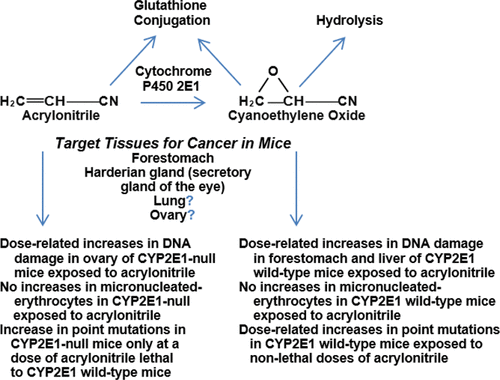当前位置:
X-MOL 学术
›
Chem. Res. Toxicol.
›
论文详情
Our official English website, www.x-mol.net, welcomes your
feedback! (Note: you will need to create a separate account there.)
Analysis of Biomarkers of DNA Damage and Mutagenicity in Mice Exposed to Acrylonitrile.
Chemical Research in Toxicology ( IF 3.7 ) Pub Date : 2020-06-12 , DOI: 10.1021/acs.chemrestox.0c00154 Vernon E Walker 1, 2, 3 , Dale M Walker 3, 4 , Burhan I Ghanayem 5 , George R Douglas 6
Chemical Research in Toxicology ( IF 3.7 ) Pub Date : 2020-06-12 , DOI: 10.1021/acs.chemrestox.0c00154 Vernon E Walker 1, 2, 3 , Dale M Walker 3, 4 , Burhan I Ghanayem 5 , George R Douglas 6
Affiliation

|
Acrylonitrile (ACN), which is a widely used industrial chemical, induces cancers in the mouse via unresolved mechanisms. For this report, complementary and previously described methods were used to assess in vivo genotoxicity and/or mutagenicity of ACN in several mouse models, including (i) female mice devoid of cytochrome P450 2E1 (CYP2E1), which yields the epoxide intermediate cyanoethylene oxide (CEO), (ii) male lacZ transgenic mice, and (iii) female (wild-type) B6C3F1 mice. Exposures of wild-type mice and CYP2E1-null mice to ACN at 0, 2.5 (wild-type mice only), 10, 20, or 60 (CYP2E1-null mice only) mg/kg body weight by gavage for 6 weeks (5 days/week) produced no elevations in the frequencies of micronucleated erythrocytes, but induced significant dose-dependent increases in DNA damage, detected by the alkaline (pH >13) Comet assay, in one target tissue (forestomach) and one nontarget tissue (liver) of wild-type mice only. ACN exposures by gavage also caused significant dose-related elevations in the frequencies of mutations in the hypoxanthine-guanine phosphoribosyltransferase (Hprt) reporter gene of T-lymphocytes from spleens of wild-type mice; however, Hprt mutant frequencies were significantly increased in CYP2E1-null mice only at a high dose of ACN (60 mg/kg) that is lethal to wild-type mice. Similarly, drinking water exposures of lacZ transgenic mice to 0, 100, 500, or 750 ppm ACN for 4 weeks caused significant dose-dependent elevations in Hprt mutant frequencies in splenic T-cells; however, these ACN exposures did not increase the frequency of lacZ transgene mutations above spontaneous background levels in several tissues from the same animals. Together, the Comet assay and Hprt mutant frequency data from these studies indicate that oxidative metabolism of ACN by CYP2E1 to CEO is central to the induction of the majority of DNA damage and mutations in ACN-exposed mice, but ACN itself also may contribute to the carcinogenic modes of action via mechanisms involving direct and/or indirect DNA reactivity.
中文翻译:

丙烯腈暴露小鼠的DNA损伤和致突变性生物标志物分析。
丙烯腈(ACN)是一种广泛使用的工业化学品,它通过未解决的机制在小鼠中诱发癌症。对于此报告,使用互补的和先前描述的方法在几种小鼠模型中评估了ACN的体内遗传毒性和/或致突变性,包括(i)不含细胞色素P450 2E1(CYP2E1)的雌性小鼠,其产生环氧中间体氰基环氧乙烷( CEO),(ii)男性lacZ转基因小鼠和(iii)雌性(野生型)B6C3F1小鼠。通过管饲法将野生型小鼠和CYP2E1无效小鼠以mg / kg体重分别在0、2.5(仅野生型小鼠),10、20或60(仅CYP2E1无效小鼠)ACN中暴露6周(5天/周)不会使微核红细胞的频率升高,但会在一种目标组织(前胃)和一种非目标组织(肝脏)中通过碱(pH> 13)彗星试验检测到DNA损伤的剂量依赖性显着增加。 )的野生型小鼠。用管饲法接触ACN还会引起野生型小鼠脾脏T淋巴细胞次黄嘌呤-鸟嘌呤磷酸核糖基转移酶(Hprt)报告基因突变频率的显着剂量相关升高;但是,Hprt仅在高剂量的ACN(60 mg / kg)对野生型小鼠具有致死性的情况下,CYP2E1无效小鼠中的突变频率才显着增加。同样,将lacZ转基因小鼠的饮用水暴露于0、100、500或750 ppm ACN 4周后,会导致脾脏T细胞中Hprt突变体频率出现明显的剂量依赖性升高。但是,这些ACN暴露并未使同一动物的多个组织中lacZ转基因突变的频率增加到超过自然背景水平。一起进行彗星测定和Hprt 这些研究的突变频率数据表明,CYP2E1对CEO的ACN氧化代谢对于暴露于ACN的小鼠中大多数DNA损伤和突变的诱导至关重要,但ACN本身也可能通过以下机制参与致癌作用直接和/或间接的DNA反应性。
更新日期:2020-07-20
中文翻译:

丙烯腈暴露小鼠的DNA损伤和致突变性生物标志物分析。
丙烯腈(ACN)是一种广泛使用的工业化学品,它通过未解决的机制在小鼠中诱发癌症。对于此报告,使用互补的和先前描述的方法在几种小鼠模型中评估了ACN的体内遗传毒性和/或致突变性,包括(i)不含细胞色素P450 2E1(CYP2E1)的雌性小鼠,其产生环氧中间体氰基环氧乙烷( CEO),(ii)男性lacZ转基因小鼠和(iii)雌性(野生型)B6C3F1小鼠。通过管饲法将野生型小鼠和CYP2E1无效小鼠以mg / kg体重分别在0、2.5(仅野生型小鼠),10、20或60(仅CYP2E1无效小鼠)ACN中暴露6周(5天/周)不会使微核红细胞的频率升高,但会在一种目标组织(前胃)和一种非目标组织(肝脏)中通过碱(pH> 13)彗星试验检测到DNA损伤的剂量依赖性显着增加。 )的野生型小鼠。用管饲法接触ACN还会引起野生型小鼠脾脏T淋巴细胞次黄嘌呤-鸟嘌呤磷酸核糖基转移酶(Hprt)报告基因突变频率的显着剂量相关升高;但是,Hprt仅在高剂量的ACN(60 mg / kg)对野生型小鼠具有致死性的情况下,CYP2E1无效小鼠中的突变频率才显着增加。同样,将lacZ转基因小鼠的饮用水暴露于0、100、500或750 ppm ACN 4周后,会导致脾脏T细胞中Hprt突变体频率出现明显的剂量依赖性升高。但是,这些ACN暴露并未使同一动物的多个组织中lacZ转基因突变的频率增加到超过自然背景水平。一起进行彗星测定和Hprt 这些研究的突变频率数据表明,CYP2E1对CEO的ACN氧化代谢对于暴露于ACN的小鼠中大多数DNA损伤和突变的诱导至关重要,但ACN本身也可能通过以下机制参与致癌作用直接和/或间接的DNA反应性。











































 京公网安备 11010802027423号
京公网安备 11010802027423号